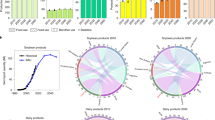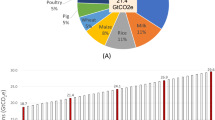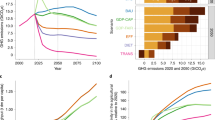Abstract
Bioenergy with carbon capture and storage, among other negative-emission technologies, is required for China to achieve carbon neutrality—yet it may hinder land-based Sustainable Development Goals. Using modelling and scenario analysis, we investigate how to mitigate the potential adverse impacts on the food system of ambitious bioenergy deployment in China and its trading partners. We find that producing bioenergy domestically while sticking to the food self-sufficiency ratio redlines would lower China’s daily per capita calorie intake by 8% and increase domestic food prices by 23% by 2060. Removing China’s food self-sufficiency ratio restrictions could halve the domestic food dilemma but risks transferring environmental burdens to other countries, whereas halving food loss and waste, shifting to healthier diets and narrowing crop yield gaps could effectively mitigate these external effects. Our results show that simultaneously achieving carbon neutrality, food security and global sustainability requires a careful combination of these measures.
This is a preview of subscription content, access via your institution
Access options
Access Nature and 54 other Nature Portfolio journals
Get Nature+, our best-value online-access subscription
$29.99 / 30 days
cancel any time
Subscribe to this journal
Receive 12 digital issues and online access to articles
$119.00 per year
only $9.92 per issue
Buy this article
- Purchase on Springer Link
- Instant access to full article PDF
Prices may be subject to local taxes which are calculated during checkout





Similar content being viewed by others
Data availability
The data supporting the findings of this study are available within the Article and Supplementary Data. Source data are provided with this paper.
Code availability
The code used to present the results in this study is available from the corresponding author upon request. The documentation for the GLOBIOM model is available online at https://iiasa.github.io/GLOBIOM/.
Change history
17 July 2023
A Correction to this paper has been published: https://doi.org/10.1038/s43016-023-00824-8
References
Schleussner, C. F. et al. Science and policy characteristics of the Paris Agreement temperature goal. Nat. Clim. Change 6, 827–835 (2016).
Fuss, S. et al. Betting on negative emissions. Nat. Clim. Change 4, 850–853 (2014).
Fujimori, S. et al. Land-based climate change mitigation measures can affect agricultural markets and food security. Nat. Food 3, 110–121 (2022).
Stenzel, F. et al. Freshwater requirements of large-scale bioenergy plantations for limiting global warming to 1.5 degrees C. Environ. Res. Lett. 14, 084001 (2019).
Stenzel, F. et al. Irrigation of biomass plantations may globally increase water stress more than climate change. Nat. Commun. 12, 1512 (2021).
Harper, A. B. et al. Land-use emissions play a critical role in landbased mitigation for Paris climate targets. Nat. Commun. 9, 2938 (2018).
Ohashi, H. et al. Biodiversity can benefit from climate stabilization despite adverse side effects of land-based mitigation. Nat. Commun. 10, 5240 (2019).
Friedlingstein, P. et al. Global Carbon Budget 2021. Earth Syst. Sci. Data 14, 1917–2005 (2022).
Carter, C. A., Zhong, F. N. & Zhu, J. Advances in Chinese agriculture and its global implications. Appl. Econ. Perspect. Policy 34, 1–36 (2012).
State Statistics Bureau China Statistical Yearbook (China Statistics Press, 2021).
Chen, X. P. et al. Producing more grain with lower environmental costs. Nature 514, 486–489 (2014).
Xue, L. et al. China’s food loss and waste embodies increasing environmental impacts. Nat. Food 2, 519–528 (2021).
He, P. et al. The environmental impacts of rapidly changing diets and their nutritional quality in China. Nat. Sustain. 1, 122–127 (2018).
Liu, J. & Savenije, H. H. G. Food consumption patterns and their effect on water requirement in China. Hydrol. Earth Syst. Sci. 12, 887–898 (2008).
Zhou, M. et al. Mortality, morbidity, and risk factors in China and its provinces, 1990–2017: a systematic analysis for the Global Burden of Disease Study 2017. Lancet 394, 1145–1158 (2019).
Liu, X. Y. et al. Dietary shifts can reduce premature deaths related to particulate matter pollution in China. Nat. Food 2, 997–1004 (2021).
Cui, K. & Shoemaker, S. P. A look at food security in China. NPJ Sci. Food 2, 4 (2018).
Zhao, H. et al. China’s future food demand and its implications for trade and environment. Nat. Sustain. 4, 1042–1051 (2021).
Smith, P. et al. How much land-based greenhouse gas mitigation can be achieved without compromising food security and environmental goals? Glob. Change Biol. 19, 2285–2302 (2013).
Heck, V. et al. Biomass-based negative emissions difficult to reconcile with planetary boundaries. Nat. Clim. Change 8, 151–155 (2018).
Humpenoder, F. et al. Large-scale bioenergy production: how to resolve sustainability trade-offs? Environ. Res. Lett. 13, 024011 (2018).
van der Hilst, F. et al. Spatial variation of environmental impacts of regional biomass chains. Renew. Sustain. Energy Rev. 16, 2053–2069 (2012).
Jerrold, L. Location, location, location. Am. J. Orthod. Dentofacial Orthop. 121, 428–429 (2002).
Zhang, A. P. et al. The implications for energy crops under Chinaa’s climate change challenges. Energy Econ. 96, 105103 (2021).
Weng, Y. W. et al. Exploring the impacts of biofuel expansion on land use change and food security based on a land explicit CGE model: a case study of China. Appl. Energy 236, 514–525 (2019).
Fricko, O. et al. The marker quantification of the Shared Socioeconomic Pathway 2: a middle-of-the-road scenario for the 21st century. Glob. Environ. Change 42, 251–267 (2017).
Liu, B. B. et al. Promoting potato as staple food can reduce the carbon–land–water impacts of crops in China. Nat. Food 2, 570–577 (2021).
Hasegawa, T. et al. Climate change impact and adaptation assessment on food consumption utilizing a new scenario framework. Environ. Sci. Technol. 48, 438–445 (2014).
Dhakal, S. et al. in Climate Change 2022: Mitigation of Climate Change (eds Shukla, P. R. et al.) Ch. 2 (IPCC, Cambridge Univ. Press, 2022).
Chang, J. F. et al. Reconciling regional nitrogen boundaries with global food security. Nat. Food 2, 700–711 (2021).
Hu, Y. C. et al. Food production in China requires intensified measures to be consistent with national and provincial environmental boundaries. Nat. Food 1, 572–582 (2020).
Meat and Dairy Production (Our World in Data, accessed 7 January 2022); https://ourworldindata.org/meat-production
Chinese Dietary Guidelines 2022 (Chinese Nutrition Society, 2022); http://dg.cnsoc.org/newslist_0402_1.htm
Zhu, Z. et al. Integrated livestock sector nitrogen pollution abatement measures could generate net benefits for human and ecosystem health in China. Nat. Food 3, 161–168 (2022).
Zhang, W. et al. Closing yield gaps in China by empowering smallholder farmers. Nature 537, 671–674 (2016).
Gong, P. China needs no foreign help to feed itself. Nature 474, 7 (2011).
Havlik, P. et al. Global land-use implications of first and second generation biofuel targets. Energy Policy 39, 5690–5702 (2011).
Havlik, P. et al. Climate change mitigation through livestock system transitions. Proc. Natl Acad. Sci. USA 111, 3709–3714 (2014).
Lauri, P. et al. Woody biomass energy potential in 2050. Energy Policy 66, 19–31 (2014).
Li, W. et al. Mapping the yields of lignocellulosic bioenergy crops from observations at the global scale. Earth Syst. Sci. Data 12, 789–804 (2020).
Frank, S. et al. Reducing greenhouse gas emissions in agriculture without compromising food security? Environ. Res. Lett. 12, 105004 (2017).
Fujimori, S. et al. A multi-model assessment of food security implications of climate change mitigation. Nat. Sustain. 2, 386–396 (2019).
Latka, C. et al. Paying the price for environmentally sustainable and healthy EU diets. Glob. Food Sec. 28, 100437 (2021).
Hasegawa, T. et al. Tackling food consumption inequality to fight hunger without pressuring the environment. Nat. Sustain. 2, 826–833 (2019).
Hasegawa, T. et al. Land-based implications of early climate actions without global net-negative emissions. Nat. Sustain. 4, 1052–1059 (2021).
Frank, S. et al. Structural change as a key component for agricultural non-CO2 mitigation efforts. Nat. Commun. 9, 1060 (2018).
Frank, S. et al. Agricultural non-CO2 emission reduction potential in the context of the 1.5 degrees C target. Nat. Clim. Change 9, 66–72 (2019).
Hasegawa, T. et al. Food security under high bioenergy demand toward long-term climate goals. Climatic Change 163, 1587–1601 (2020).
Lotze-Campen, H. et al. Impacts of increased bioenergy demand on global food markets: an AgMIP economic model intercomparison. Agric. Econ. 45, 103–116 (2014).
Wang, M. et al. Increasing nitrogen export to sea: a scenario analysis for the Indus River. Sci. Total Environ. 694, 133629 (2019).
Leclere, D. et al. Bending the curve of terrestrial biodiversity needs an integrated strategy. Nature 585, 551–556 (2020).
Molotoks, A. et al. Comparing the impact of future cropland expansion on global biodiversity and carbon storage across models and scenarios. Phil. Trans. R. Soc. B 375, 20190189 (2020).
Obersteiner, M. et al. Assessing the land resource–food price nexus of the Sustainable Development Goals. Sci. Adv. 2, e1501499 (2016).
Pastor, A. V. et al. The global nexus of food–trade–water sustaining environmental flows by 2050. Nat. Sustain. 2, 499–507 (2019).
Janssens, C. et al. Global hunger and climate change adaptation through international trade. Nat. Clim. Change 10, 829–835 (2020).
Janssens, C. et al. International trade is a key component of climate change adaptation. Nat. Clim. Change 11, 915–916 (2021).
Implementing Plan to Promote the Action to Achieve Zero Growth of Chemical Fertilizer Use by 2020 (Ministry of Agriculture and Rural Affairs of the People’s Republic of China, 2015); http://www.moa.gov.cn/nybgb/2015/san/201711/t20171129_5923401.htm
Outline of National Mid-Long-Term Plan for Food Security (2008–2020) (Central People’s Government of the People’s Republic of China, 2008); http://www.gov.cn/jrzg/2008-11/13/content_1148414.htm
OECD & FAO OECD–FAO Agricultural Outlook 2022–2031 (OECD Publishing, 2022); https://doi.org/10.1787/f1b0b29c-en
IPCC 2006 IPCC Guidelines for National Greenhouse Gas Inventories (eds Eggleston, H. et al.) (IGES, 2006).
FAOSTAT: Food and Agriculture Data (FAO, 2022); https://www.fao.org/faostat/en/#home
Herrero, M. et al. Biomass use, production, feed efficiencies, and greenhouse gas emissions from global livestock systems. Proc. Natl Acad. Sci. USA 110, 20888–20893 (2013).
Sandstrom, V. et al. The role of trade in the greenhouse gas footprints of EU diets. Glob. Food Sec. 19, 48–55 (2018).
Ma, L. et al. Exploring future food provision scenarios for China. Environ. Sci. Technol. 53, 1385–1393 (2019).
Bai, X. M., Shi, P. J. & Liu, Y. S. Realizing China’s urban dream. Nature 509, 158–160 (2014).
Ma, L. et al. Environmental assessment of management options for nutrient flows in the food chain in China. Environ. Sci. Technol. 47, 7260–7268 (2013).
Transforming Our World: The 2030 Agenda for Sustainable Development (United Nations, 2015); https://sdgs.un.org/2030agenda
English, L. K. et al. Evaluation of dietary patterns and all-cause mortality: a systematic review. JAMA Netw. Open 4, e2122277 (2021).
Murray, C. J. L. et al. Global burden of 87 risk factors in 204 countries and territories, 1990–2019: a systematic analysis for the Global Burden of Disease Study 2019. Lancet 396, 1223–1249 (2020).
Carrero, J. J. et al. Plant-based diets to manage the risks and complications of chronic kidney disease. Nat. Rev. Nephrol. 16, 525–542 (2020).
Stylianou, K. S., Fulgoni, V. L. III & Jolliet, O. Small targeted changes can yield substantial gains for human health and the environment. Nat. Food 2, 616–627 (2021).
Tilman, D. & Clark, M. Global diets link environmental sustainability and human health. Nature 515, 518–522 (2014).
Semba, R. D. et al. Adoption of the ‘planetary health diet’ has different impacts on countries’ greenhouse gas emissions. Nat. Food 1, 481–484 (2020).
Zhuo, L. et al. Sensitivity and uncertainty in crop water footprint accounting: a case study for the Yellow River basin. Hydrol. Earth Syst. Sci. 18, 2219–2234 (2014).
Hawkins, J. W. et al. High-yield dairy cattle breeds improve farmer incomes, curtail greenhouse gas emissions and reduce dairy import dependency in Tanzania. Nat. Food 3, 957–967 (2022).
Van Vuuren, D. P. et al. Energy, land-use and greenhouse gas emissions trajectories under a green growth paradigm. Glob. Environ. Change 42, 237–250 (2017).
Fujimori, S. et al. SSP3: AIM implementation of Shared Socioeconomic Pathways. Glob. Environ. Change 42, 268–283 (2017).
Duan, H. B. et al. Assessing China’s efforts to pursue the 1.5 degrees C warming limit. Science 372, 378–385 (2021).
Xing, X. F. et al. Spatially explicit analysis identifies significant potential for bioenergy with carbon capture and storage in China. Nat. Commun. 12, 3159 (2021).
Yang, Q. et al. Prospective contributions of biomass pyrolysis to China’s 2050 carbon reduction and renewable energy goals. Nat. Commun. 12, 1698 (2021).
Xing, J. et al. Integrated crop–livestock–bioenergy system brings co-benefits and trade-offs in mitigating the environmental impacts of Chinese agriculture. Nat. Food 3, 1052–1064 (2022).
Acknowledgements
This study was supported by the National Science Fund for Outstanding Young Scholars (grant no. 72222001) (H.D.), the National Key Research and Development Program of the Ministry of Science and Technology of China (grant no. 2022YFE0138300) (H.D.), the National Natural Science Foundation of China (grant nos 72073003, 71810107001 and 72234002) (H.D.), the National Social Science Foundation of China (grant no. 21AZD060) (H.D.), the European Union’s Horizon 2020 research and innovation programme under the ENGAGE (grant no. 821471) (P.H.) and NAVIGATE (grant no. 821124) (P.H.) projects, the China Postdoctoral Science Foundation (grant no. 2022M720212) (C.H.) and the Youth Academic Program in Area Studies of Peking University (grant no. 7101602310) (C.H.). We acknowledge the Peking University–IIASA Postdoctoral Program for providing funding and collaboration opportunities (no grant number).
Author information
Authors and Affiliations
Contributions
M.R., H.D. and P.H. designed the study. M.R. ran the model and performed the analysis with the help of A.D. and S.F. C.H. drew the figures. M.R., H.D. and P.H. wrote the manuscript with major contributions from all co-authors.
Corresponding author
Ethics declarations
Competing interests
The authors declare no competing interests.
Peer review
Peer review information
Nature Food thanks Wei Li and the other, anonymous, reviewer(s) for their contribution to the peer review of this work.
Additional information
Publisher’s note Springer Nature remains neutral with regard to jurisdictional claims in published maps and institutional affiliations.
Extended data
Extended Data Fig. 1
The conceptual research framework of interconnected impacts of bioenergy deployment on selected sustainability indicators.
Extended Data Fig. 2
Overview of detailed modeling framework.
Extended Data Fig. 3 Projections of China’s agricultural imports in 2060.
a–f, The lengths of the red suspended bars indicate the absolute marginal change in each scenario compared with the scenario to its above; the number beside each red bar is obtained by dividing the abovementioned absolute change by the corresponding value in the Reference scenario. The length of the final bar is the value for the FoodSystem scenario.
Extended Data Fig. 4 Sensitivity of sustainability impacts to changes in uncertain input variables.
Absolute changes (top) in sustainability indicators and elasticity (bottom) in 2060. The mapping of sensitivity scenarios, baseline scenarios, and inputs and the proxy variables of inputs for calculating elasticities is shown in Supplementary Table 11. Methods and Supplementary Table 8 present sensitivity scenarios in further detail. The right side shows the uncertain input variables and the left side shows the sensitivity scenarios. The first six indicators (top) are China’s domestic sustainability, and the last four indicators are virtually imported environmental impacts from China’s trading partners.
Supplementary information
Supplementary Information
Supplementary Figs. 1–34, Tables 1–14, Methods and Discussion.
Supplementary Data 1
Data supporting the findings of this study including China’s domestic sustainability, trade of agricultural products and virtually imported environmental impacts from China’s trading partners due to agricultural imports.
Source data
Source Data Fig. 1
Statistical source data.
Source Data Fig. 2
Statistical source data.
Source Data Fig. 3
Statistical source data.
Source Data Fig. 4
Statistical source data.
Source Data Fig. 5
Statistical source data.
Source Data Extended Data Fig. 3
Statistical source data.
Source Data Extended Data Fig. 4
Statistical source data.
Rights and permissions
Springer Nature or its licensor (e.g. a society or other partner) holds exclusive rights to this article under a publishing agreement with the author(s) or other rightsholder(s); author self-archiving of the accepted manuscript version of this article is solely governed by the terms of such publishing agreement and applicable law.
About this article
Cite this article
Ren, M., Huang, C., Wu, Y. et al. Enhanced food system efficiency is the key to China’s 2060 carbon neutrality target. Nat Food 4, 552–564 (2023). https://doi.org/10.1038/s43016-023-00790-1
Received:
Accepted:
Published:
Issue Date:
DOI: https://doi.org/10.1038/s43016-023-00790-1
This article is cited by
-
Efficient food systems for greater sustainability
Nature Food (2023)



